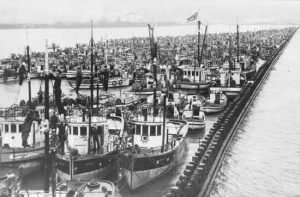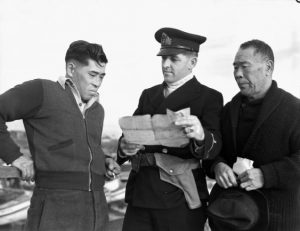Reflection
Stepping onto the docks at Steveston, I wanted to drop out of school and become a fisherman. Every time I step on the water I think about it. The smell of the ocean and the wooden docks, the sound of the boats & birds, and the feel of the sea makes me deeply happy.
But it didn’t take long for my dream to burst. Walking through the boats with Eric Wickham, I started to notice “For Sale” signs on many of the boats. Eric pointed out that many of the boats had not been out fishing for years. You could look in their helm windows to see their licences, last registered for 5, 8, even 10 years ago.
I really valued Eric’s time and knowledge on the field trip. I love hearing stories from sailors and fishermen, and his experience was particularly insightful. When asked why he thought fish stocks were declining, he had the striking response: “Computers killed the fish”. (As a computer science student I was alarmed by this.) He went on to explain how the DFO used to have fisheries officers in all the main port areas. These fisheries officers were out on the docks, talking to fishermen, and they had a real sense of what was going on within the small-scale commercial fisheries.
According to Eric, this all changed once computers attacked! The digitalization of fisheries research meant that fishery data could now be collected by transient teams of scientists and sent back directly to DFO headquarters. This digitization made the local fishery officers superfluous in the eyes of the DFO, and they were hence removed. This created a communication breakdown and left the DFO more out of touch than ever with fishermen.
Eric blamed computers for giving the DFO too much faith in their data and science. This issue is something I have come across frequently in my work in the tech sector. Last year I worked for 8 months at SAP making data analytics software, and my amazing manager gave me a valuable proverb to guide my career: “behind every technical problem is a human problem”. Our company’s purpose is to sell and run world-class data analytics, but even we had realised that data analysis is not a replacement for communication. In the technology industry there is huge pressure to have a ‘data-driven approach’, but this can often leave organizations with significant blind spots. I see alarming parallels to the DFO here, since they have adopted an almost exclusively data-driven approach.
Considering the localized fishing issues we have discussed in class, many of them are exacerbated by a lack of communication between managers and fishers. In comparison, many of the success stories we covered in class had strong outreach and communication channels established.
I thought of Eric’s comments when Dr. Megan Bailey spoke to our class. She mentioned how fishermen in Nova Scotia were very open about not correctly reporting their data to the DFO. In this example Dr. Bailey was playing the role that fisheries officer used to play: getting boots on the ground and talking to fishermen in the community. This case study highlighted a very real example of Eric’s concerns.
It was also interesting and a little sad to see the massive trawlers on the end of the dock. They were huge, and Eric mentioned that the biggest one had recently sold for $11 million. In contrast to many of the smaller boats on the dock, the behemoth trawlers were in good repair and apparently still go out fishing frequently. It was concerning to hear that due to their large scale and economic weight, the large trawlers have much better representation in Ottawa. Eric explained that the small-scale commercial fishermen do not have a communication channel to the DFO or policy makers; they are limited to “fighting amongst themselves in local pubs”.
Moving on to the second part of the field trip, I was overwhelmed with gratitude for how much society in BC has improved since the 1800s. The abhorrent racisms and suppression of Chinese, Japanese, and indigenous communities in Stevenson was a lot to take in. While there are still significant social injustices today, they paled in comparison to the ones we learned about in the Cannery tour, and it made me appreciate society’s progress. For example, the automatic salmon butcher machine was registered as the “Iron Chink” until the 1970s. The 1970s?? The tour reminded me how short my time horizon is, and how quickly societies can change.
As a sailor, I was excited to learn about the Japanese ship building influence. Japanese ship builders transformed the fishing industry on the West Coast. European boats were small, sail-powered dinghies no more than 15-20 feet long, while the Japanese boats were upwards of 30 feet, and much more seaworthy. The Japanese were quick to integrate gas-powered engines, and with that they could build bigger boats and catch more fish. Additionally, Japanese shipbuilders pioneered continuous plank frames, giving their boats unparalleled strength [1]. Today, the typical fishing boat found on the Steveston docks closely resembles the Japanese fishing boats of the early 1900s.
I was intrigued by the Japanese influence on local fisheries, and I went down a rabbit hole researching the topic after returning from the field trip. By 1919, Japanese-Canadian fishermen held the majority of all fishing licences in the province. The strong fishing community formed the “Japanese Fishermen’s Benevolent Association”, and together they created a hospital in Steveston. According to the BC Maritime Museum, this was the first example of universal healthcare in Canada, since all members of the association could receive treatment for free [1].
Sadly BC’s reaction to the attack on Pearl Harbour destroyed the Japanese-Canadian fishing community. Within days of the bombing, the province impounded 1,130 Japanese-Canadian fishing vessels. Sadly, many of the boats were damaged or destroyed, and some were even used as fill on Annacis Island [1]. After World War II very few Japanese-Canadian fishermen returned, only 16% of fishing licences in BC belonged to Japanese-Canadians.

Figure 1. Impounded Japanese-Canadian fishing boats tied up on the Fraser River in 1942. Notice the hull design: typical of Japanese ship builders, and still seen today in many fishing boats. Origin: Vancouver Public Library photo: 26951. Source: https://www.vancouverisawesome.com/courier-archive/news/archives-navy-seizes-japanese-fishing-boats-2990514

Figure 2. A Royal Canadian Navy officer questions Japanese-Canadian fishermen after seizing their boats. This photo and their facial expressions are heart breaking to me. Source: https://www.vancouverisawesome.com/courier-archive/news/archives-navy-seizes-japanese-fishing-boats-2990514 Date and origin unknown.
Finishing the field trip with a walk to the Fishermen’s Memorial help drive home the reality of the fishing industry. It is dangerous, grueling work that has cost many lives. It was sad to see many surnames repeated along the memorial, where many members of the same family had been lost at sea.
Overall the field trip was engaging, fun, and eye-opening. It hugely expanded my understanding of local fishing history, and I am excited to keep learning more!
References:
[1] Takeuchi, C. (2017, March 28). Vancouver exhibit on Japanese Canadian fishing VESSEL seizures asks if history will repeat itself. Retrieved April 4, 2021, from https://www.straight.com/arts/886011/vancouver-exhibit-japanese-canadian-fishing-vessel-seizures-asks-if-history-will-repeat
[2] Archives: Navy seizes Japanese fishing boats. (2014, December 8). Retrieved April 4, 2021, from https://www.vancouverisawesome.com/courier-archive/news/archives-navy-seizes-japanese-fishing-boats-2990514